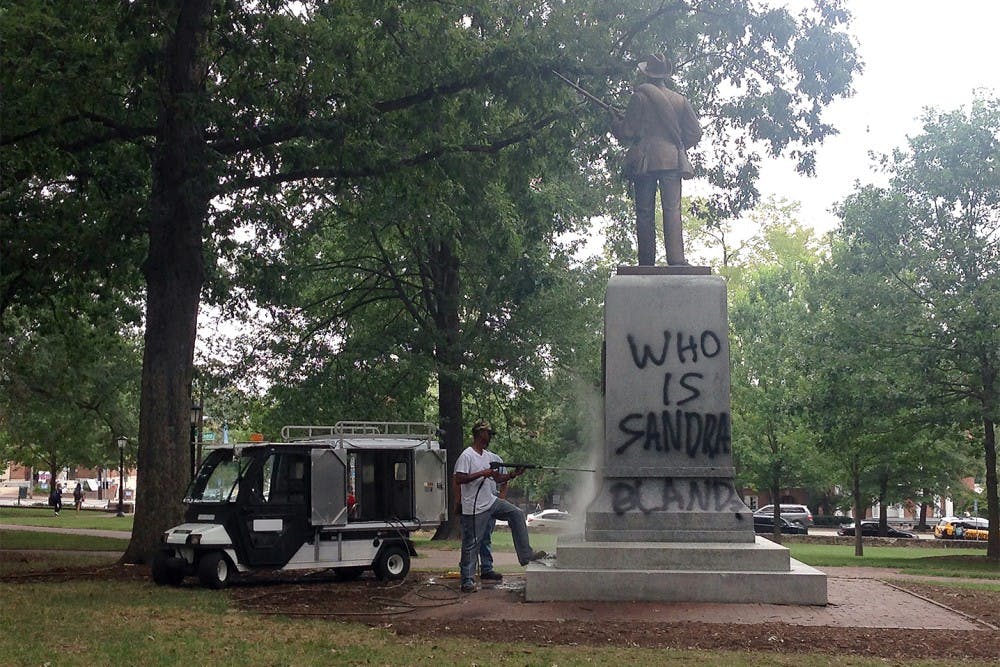Mecimore said the same phrase was spray-painted on the pillars in front of the Chapel Hill Courthouse, just across Franklin Street from the Silent Sam monument.
“In all likelihood, it is the same person or the same group that spray-painted them,” he said.
A spokesman for the Department of Public Safety, which has jurisdiction over Silent Sam and the rest of campus, did not return multiple phone calls and messages requesting the department’s response Tuesday.
Around 11 a.m. Tuesday, several University facilities service workers arrived to remove the graffiti from the Confederate monument. Town of Chapel Hill employees removed the courthouse graffiti earlier in the morning.
Angelo Baldwin , who is black, was one of the workers removing the message from the statue’s base. He said he thought the graffiti should receive less attention.
“As long as the media keeps reporting it, we’re going to have everybody against each other,” Baldwin said. “I think it should be pretty much an inside-type thing where we get (the graffiti) off and we keep moving and not make such a big deal or national news about it.”
Geography professor Altha Cravey, who herself was in the news over the summer for refusing to remove “Hurston Hall” signs from her office in the building known as Carolina Hall, said the opposite. She said the University administration has not sufficiently publicized these issues or treated them with enough gravity.
Cravey said that following the incident, she spoke with several members of The Real Silent Sam Coalition, a student activist group that has advocated the removal of racially charged vestiges of the Confederacy from campus.
She said the members she talked to were surprised by the spray-painting. “But there’s also just an awareness,” she said. “There’s a keen awareness among people I know in Silent Sam that these racial tensions are extremely high.”
Cravey also said administrators have been “unwilling to address the pain of the message of Real Silent Sam students, especially those that are really pushing the activism there.”
The Real Silent Sam Coalition decided not to offer an official response; one member said the group was on “media lockdown.”
Student Body President Houston Summers said Chancellor Carol Folt informed him directly of the incident on Tuesday morning at the athletic breakfast event the two were attending.
To get the day's news and headlines in your inbox each morning, sign up for our email newsletters.
“My immediate reaction was, ‘Man, well this stinks,’” Summers said. However, he said the spray-painting was completely understandable.
“I’m not saying that students should go around spray-painting things as an expression of their concerns, but at the same time, it’s a manifestation of a failure on our part to provide enough substantial areas for conversation,” he said.
When asked whether the memorial should come down, Summers hedged his answer, saying the issue is as complex as the renaming of the building formerly known as Saunders Hall.
“It’s very important that we holistically look at this issue and support every student involved,” he said. “It takes a little more time than ‘rip it down’ or ‘keep it up.’”
The University’s official response, issued later Tuesday morning via spokesman Jim Gregory, also cited the importance of free speech at UNC, but explicitly condemned the spray-painting.
“Vandalism like this is unfortunate because it is the antithesis of open discussion and the traditions and principles for which the University stands,” the statement said.
The incident’s timing — on the first day of the semester’s classes — made the message especially powerful for some students.
Senior English and economics major Thomas Alexander, who is white, said he’s glad the discussion is being raised for the entire school year. “It’s definitely a statement for the semester,” he said.
And for about a quarter of UNC’s population, the experience was even more of a first. Freshman Madison Forsey, who is white, said that on her first-ever day of college classes, the incident manifested racial topics she’d heard discussed Monday at the talk with summer reading author Bryan Stevenson.
“This morning, after seeing that,” she said, “you realize that there are real-world problems and real-world divides even here on campus, like he talked about.”
Assistant University Editor Hannah Smoot contributed reporting.
@drewlgoins
university@dailytarheel.com




